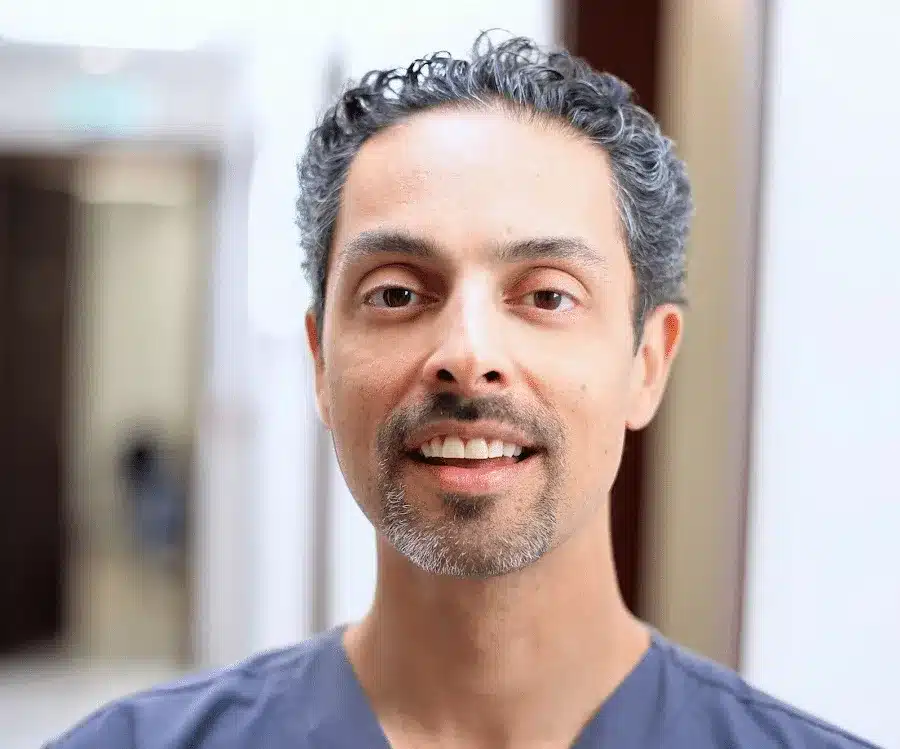Natural Blepharoplasty Surgery in Harley Street, London
 Dr Julian De Silva #1 Specialist Blepharoplasty Surgeon
Dr Julian De Silva #1 Specialist Blepharoplasty Surgeon
 Over 1000 5-Star Patient Experiences
Over 1000 5-Star Patient Experiences
 Fast Recovery Technology
Fast Recovery Technology
 Natural Artistry
Natural Artistry
 The Da Vinci of Facial Surgery
The Da Vinci of Facial Surgery

FACELIFT SURGERY IN HARLEY STREET
What is Blepharoplasty?

As a combination of ageing and genetics, the skin and muscle around the eyelids loosens, resulting in loose skin, puffiness and dark rings that may give you a tired appearance. In addition, there are often changes in the anatomy that results in puffiness owing to fat protruding into the eyelids forming bags in the lower and upper eyelids.
In expert hands eyelid surgery rejuvenates your facial appearance, making you look fresher and less tired. The eyelid anatomy is intricate, and blepharoplasty involves a combination of reshaping excess skin, muscle and prolapsing fat. Dr De Silva focuses on meticulous techniques to ensure a natural-looking result.
Why have Blepharoplasty? Benefits?
Our eyes are so important, whenever you meet someone where social or professional you make eye contact. The appearance of your eyes form part of your first impression on meeting someone, they can make you look fresh and engageing or tired and ageing.
As you age, the natural elasticity of our skin diminishes. This results in fine lines and wrinkles, sagging skin, and a tired, aged appearance. Younger people can have puffiness as a result of genetics. A signature blepharoplasty offers many benefits, including:
- Natural results, means the best version of you.
-
Loose skin, puffiness or wrinkles are readily seen, and common symptoms patients describe include being asked if they are tired, stressed or lacking sleep.
-
Heavy upper eyelids, dark circles or bags around the lower eyes, often lead to a tired and aged look.
- Old photograph from your 20s to 30s can be helpful. The details around the eyes are of great importance, as subtle changes of even less than half a millimetre can be discernible between the right and left sides.
- ‘Puffy Eyelids & bags‘ are what people associate with tiredness or stress. Friends and family often say you are tired and you are not.
- No creams help, despite these marketing claims. These changes are related to anatomy and usually required blepharoplasty (early changes filler can be used).
- ‘Less is more approach‘ important in the delicate area of the eyes. We treat many patients with revision blepharoplasty, so important that this area scars are hidden and the procedure is completed meticulously.
- Commonly our patients find a boost in confidence.
- Blepharoplasty offers a longer lasting permanent solution. Some patients may be frustrated with the temporary nature of fillers and non-surgical treatments.
In the Press
Why Choose Dr De Silva in Harley Street, London ?
Dr Julian De Silva is a widely credited and celebrated facial plastic surgeon who specialises ONLY in the FACE. Eyelid surgery, AKA blepharoplasty is the No.1 procedure that he helps patients with every day. Your face has intricate anatomy; your eyes, nose, face and neck areas, and relatively unique. Dr Julian De Silva is known for Natural Results & Fast Recovery technology.
“We are proud to have over 1000 5* reviews. My focus has always been to be the very best at what I do, to continually innovate to provide World Class leadership with my team, my patients and my associates. My mission is to help every patient be the very best version of themself with World-Class services, life-long follow up with complimentary facial aesthetic procedures.”
Author of the Blepharoplasty Book, The Patient Guide to Blepharoplasty & Eyelid Surgery, to help our patients make the best decisions we gift this book to all our patients. In a world of increasing complexity and misinformation, his passion has been focused on providing sincere advice, low risk and fast recovery procedures.
As an Artist, Dr De Silva’s paintings decorate the walls of the World Class Facility at 23 Harley Street, custom built for Facial Treatments.
Dr Julian De Silva has Taught Surgery to other surgeons in the USA for over 8 years. “I have always been a passionate teacher and as director of the course I am committed to inspiring the next generation of surgeons.”
As a father and a Family Man he understands how important our appearance, health and well being is for happiness. Dr De Silva is in demand, please be patient if we are unable to offer you an appointment immediately, Dr De Silva is a detailed surgeon, he takes extra time with every patient to understand your needs and expectations, facial treatment is a blend of both precision and artistry, and takes time.
Only the Face
By focusing entirely on only facelift & facial cosmetic surgery procedures, Dr De Silva is able to provide the expertise that can only come with specialisation: facelift and neck lift, blepharoplasty, rhinoplasty and chin implants.
Natural Looking Results
Dr De Silva is a believer in the importance of artistry behind cosmetic results and focuses his skills at delivering natural looking results.
Fast Recovery
Dr De Silva has pioneered the advances in technology to speed up recovery with a combination regenerative medicine techniques, Oxygen and LED Therapy.
World Class Expertise
Dr De Silva also teaches other surgeons internationally and has contributed to the development of advanced surgical techniques, laser technology and stitch-less tissue adhesives.
Natural Blepharoplasty Surgery in London
Eyelid Surgery Overview
Benefits of Eyelid Surgery
- Every person’s eyes are different, so bring an old photo from your 20s to your consultation.
- Scars must be positioned discreetly; 99% virtually invisible (meticulous technique, multiple levels of stitches, no shortcuts)
- Additional procedures can enhance blepharoplasty, including laser resurfacing and fat transfer. They are of key importance to give a long-lasting result that will last 10 years or more and avoid the need for filler.
- Older techniques in the lower eyelid can result in scars and change in shape in the eyelid. Dr De Silva uses modern techniques, performing surgery on the inside of the eye (Trans-Conjunctival blepharoplasty) for scar-free results
Uses modern anaesthesia (termed sedation anaesthesia) which is far safer and with a faster recovery than traditional general anaesthesia. - With Dr De Silva’s sedation anaesthesia avoid general anaesthesia. All patients experience rapid recovery less than 30 minutes after procedure.
Reasons for Eyelid Surgery
- Tired appearance; feel or look older
- Self-conscious; avoid photos
- Impact on relationships & profession
- Difficulty with makeup; concealer to camouflage changes
- Difficulty with makeup; concealer to camouflage changes
- Genetic component; starting to look like your mother or father
- Tried every lotion and potion to improve eyelids; minimal effect
- Disappointed with non-surgical treatments like Plexa; <10% improvement
- Revision Blepharoplasty. We help many patients who have not had satisfactory results from their previous surgeon.
What are the risks of eyelid surgery?
Blepharoplasty is demanding and requires in-depth knowledge of the anatomy of the eye area, as well as attention to detail.
One of the most important factors responsible for the success of surgery is the surgeon. In Dr De Silva’s hands complications are uncommon, with swelling and bruising being the most common aspects of recovery.
Pain or discomfort are uncommon and resolve within 24-hours. Infection is very rare, and the gold standard is prophylactic antibiotics to protect against infection.
Dr De Silva avoids the side effects of general anaesthetic (deep vein thrombosis and allergies) by using safer sedation anaesthesia.
Two rare and serious complications are eyelid retraction and damage to vision. Dr De Silva has never had a patient of his own have these complications. However, he takes multiple levels of precautions to avoid these issues in the first place.
The eyelids have an intricate anatomy of millimetres. Thus, an oculo-plastic surgeon specialising in this area of the face is best suited to ensure a smooth journey and successful result.
What are things you can do to speed up blepharoplasty recovery?
- Dr De Silva and his team gives comprehensive advice to all his patients on what should be avoided before and after surgery. For example, there are some herbal medications, such as arnica, that should be taken to reduce bleeding.
- Our team will cover this in detail with you and we provide 5* service and support along the journey from the procedure to celebrating the results.
- Icing the eyelids for the first three days, in the form of ice in a zip lock bag, frozen peas or gel mask all have a beneficial effect on reducing swelling when applied to the eyelids for ten minutes regularly after surgery.
- There are other factors such as resting and taking things easy during the daytime that will maintain a relatively low and stable blood pressure. Keeping your head elevated when sleeping, will also reduce bruising and swelling.
World Class Facial Cosmetic and Plastic Surgery
Natural Blepharoplasty Before & Afters
Dr De Silva has transformed thousands of faces through his unique surgical techniques. Below is a small sample of some of his transformations.






TESTIMONIAL
What our satisfied clients are saying
“Having Lower Blepharoplasty with Dr. De Silva gives you the benefit of years of experience, qualifications not only in the U.K. but also the U.S. and yet you don’t lose the gentle bedside manner from this doctor. From our first meeting, Dr. De Silva won me over because he gave me the time to obtain answers and explanations to all my questions in kind details, as many times as I needed.”
Sandra
Eyelid/Blepharoplasty
Frequently Asked Questions
What is different about Dr De Silva’s blepharoplasty technique?
Dr De Silva as an Oculo-Facial Plastic surgeon specialises in blepharoplasty and facial surgery, he does not operate on other parts of the body. By specialising in only facial cosmetic surgery, he has developed specialist expertise and technical skills. Dr De Silva tailors his surgical skills for the individual patient, uses hidden incision techniques, thereby avoiding visible scars, however to give the best possible results he uses additional facial techniques in over eight percent of cases.
Dr De Silva worked in the cosmetic surgery havens of Los Angeles and New York amongst the best Facial Plastic Surgeons in blepharoplasty in the World, and developed skills, including 3-D telescopic camera techniques & invisible incision techniques, that at the time were not available in fellowship training in the UK. Dr De Silva uses a variety of sculpting and suturing techniques to preserve the function and structural integrity of the eyelids, which give a natural rejuvenation. A combination of tried and tested techniques and new innervational techniques.
Dr De Silva is a keen teacher and has taught numerous instructional courses and led the development of new courses. Dr De Silva teaches facial cosmetic and plastic skills at the prestigious American Society of Oculo-Facial Plastic Surgery conference in the USA.
Dr De Silva is an artist having painted for exhibitions in London at the Royal Academy of Arts and National Portrait Gallery and a sculptor of clay. The sculpting of the human face to balance the proportions of the face and body-type require both artistic interpretation and technical know-how.
Dr De Silva trained in microscopic surgery before cosmetic surgery. In micro-surgery millimetres makes the difference between success and failure. Using these same principles of microsurgical finesse and obsession to detail, Dr De Silva is able to give natural looking blepharoplasty results. Dr De Silva recognizes limitations in surgical results that may be a result of past scarring, skin thickness or trauma, and will advise you against surgery if he believes that a patient is unlikely to obtain the result they desire.
Occasionally patients may have expectations that far exceed the likely results from surgery, if the likely result is below a patient’s expectations Dr De Silva will advise against surgery.
Blepharoplasty is a challenging procedure and is regarded as each person’s eyelids are relatively unique and a natural rejuvenation requires meticulous attention to detail. Dr De Silva advises patients seeking blepharoplasty surgery to see a meticulous surgeon who specialise in eyelid surgery for this reason.
Dr De Silva performs a conservative blepharoplasty that preserves the natural architecture of the eyelid, by using tissue-sparing techniques, and avoiding unnecessary trauma to the intricate anatomy of the eyelids, this prevents the surgical signs of complicated blepharoplasty such as eyelid retraction or change in natural eyelid shape.
Dr De Silva’s customised Natural Blepharoplasty Technique, from Dr De Silva Textbook on Blepharoplasty, AKA eyelid surgery
How long does the procedure take?
Depending upon the scope of the procedure, the operation takes approximately 1 to 3 hours to complete. The procedure may be completed only on the upper eyelids, the lower eyelids or both concurrently. Commonly blepharoplasty may be combined with tightening of the lower eyelid tendon (canthopexy or canthoplasty) or rejuvenation of the lower eyelid skin (laser treatment or skin peels) or volume restoration (e.g. fat transfer) to give the best natural results.
Eyelid surgery can be completed in 1 hour. However to obtain the best natural results that are long lasting, the procedure will take 1-3 hours as it will require a combination of fat transfer, fat preservation, skin resurfacing, regenerative medicine and attention to detail for natural results that are long lasting. Many surgeons do not use fat transfer for this procedure however the results will not be as good or long lasting and other volume may be required such as maintenance with fillers. Dr De Silva customised blepharoplasty to the individual patient and most procedures take between 1.5 to 3 hours depending on the intricacy and complexity of the procedure. From Dr De Silva’s experience customised blepharoplasty surgery can last 10 years in the majority of patients and a lifetime in some patients.
Is there much discomfort or pain after blepharoplasty surgery?
The surgery generally causes mild ache or discomfort which settles over less than 48 hours, and the surgery is not regarded as painful. Most of Dr De Silva’s patients require minimal or no analgesia after blepharoplasty. Usually over the counter mild analgesia is sufficient to reduced the discomfort (e.g. Paracetamol or Tylenol).
Are the scars noticeable after blepahroplasty surgery?
In upper blepharoplasty, the incision is hidden in the crease of the eyelid and is often difficult to see even 1 week after surgery. In lower blepharoplasty, the incision is placed either in the conjunctiva (termed transconjunctival) of the eyelid in which case it is completely hidden. Or the incision is just below the lower lid eyelashes (termed transcutaneous) within several weeks this incision is hidden by the eyelashes of the lower eyelid. The eyelid skin is unique in that it is very thin, and although rarely patient who are predisposed to scarring my have keloid scars, keloids on the eyelids are rare.
Upper Blepharoplasty Scar at 6 weeks. All scars are initially slightly pink in colour and lumpy bumpy in appearance. Over a period of weeks to months the colour returns to normal and the scar smoothens out. Dr De Silva takes care to hide scars in natural lines and creases and avoid scars wherever possible. Issues with scars are relatively rare and occur in less than 1%. Key is the detail, Dr De Silva does not use dissolvable stitches in this delicate area, as these can result in more visible scars afterwards.
Lower Blepharoplasty at 6 weeks. No scar is visible. Dr De Silva prefers to avoid scars in lower eyelid surgery by hiding the scars and completing the surgery on the inside of the eyelid. There are a small proportion of patients who may not be suitable for this technique however each patient’s surgery must be tailored to the individual to give the best possible natural looking result.
Video on How to avoid terrible scars after blepharoplasty surgery?
What are the potential risks and complications of blepharoplasty?
Blepharoplasty is the commonest cosmetic procedures to be completed in the world and is regarded as a safe procedure. As with any surgery there are potential risks and complications that many occur.
Complications in blepharoplasty may occur because of several reasons. One of the most important factors responsible for the success of surgery is the surgeon. The surgeon must have complete knowledge of how the surgery has to be performed. Blepharoplasty, particularly of the lower eyelid is demanding and requires in depth knowledge of the anatomy and attention to detail. Dr De Silva’s number one procedure is blepharoplasty and revision blepharoplasty.
Complications can be defined as any unforeseen occurrence during or after the surgery. The complications that can occur during or after blepharoplasty and can be divided into four categories; intra-operative, immediate post-operative, early and later post-operative.
Intra-operative complications occur during the surgery. For example, these can occur due to a reaction to some medication or due to the local or general anaesthesia given and are managed by the surgical team at the time of surgery.
Immediate post-operative complications occur immediately after the surgery when the patient is in the initial recovery stage and may include bleeding or a medication. These complications need to be handled immediately by the surgeon who performed the operation.
Early post-operative complications in blepharoplasty occur once the patient has been discharged. These appear almost immediately after the person returns to normal routine. They can include bleeding, a reaction to a medication, infection and can be corrected by contacting the doctor immediately.
Late post-operative complications associated with blepharoplasty may occur when the patient fails to take proper care after the surgery, the surgical technique used or the patient’s healing process. These complications include those of the upper eyelid (asymmetry, scarring, hollowing, inability to close the eyes, dry eyes), lower eyelid (asymmetry, residual fat bags, lower lid retraction). Most of these complications are minor and can be easily corrected, however some such as lower lid retraction require complex revision surgery with the use of graft material and reconstructive techniques.
The commonest complications are bleeding and bruising, all of which are treatable. There is a risk of asymmetry between the two eyes and this may settle with time or in approximately <5% cases may require a small revision procedure that can be completed under local anaesthesia. The most serious and feared complication of blepharoplasty is loss of vision following surgery, as a result of bleeding that collects behind the eye, this is an extremely rare complication and if recognized early on it can be treated. Blepharoplasty is generally a popular surgery with high patient satisfaction and low risk of complications.
Can I have blepharoplasty under local anaesthesia alone or do I need general anaesthesia?
Patients are able to have upper blepharoplasty under local anaesthesia alone, sedation or general anaesthesia. Dr De Silva has used all of these for his patients over more than 10 years, Sedation Anaesthesia offers the advantage being a more comfortable experience and faster recovery. Blepharoplasty may also be completed under local anaesthesia, however the eyelids are sensitive and delicate and the use of sedation is a useful adjunct for surgery. For best natural results eyelid surgery is often combined with other procedures such as fat grafting and skin resurfacing, with these additional procedures light sedation is generally preferred. General anaesthesia is not a requirement of blepharoplasty and associated with more recovery and potential side effects can be avoided. Dr De Silva takes time to advise each patient on the best type of anaesthesia for them. His team have pioneered the use of faster recovery sedation, aka twilight anaesthesia in London, UK, and have been awarded a patent for their innovational sedation anaesthesia technique.
Who is the best plastic surgeon for blepharoplasty in London, UK?
The best UK surgeons in 2024 according to Rate MD
- Dr Julian De Silval. Plastic/ Cosmetic Surgeon
23 Harley Street, London, London, ENG, W1G 9QN
- Dr Riccardo Frati. Plastic/ Cosmetic Surgeon
- Dr. Ayham Al-Ayoubi.
Milner House, 14 Manchester Square, London, ENG, W1U3PP
How do I choose a blepharoplasty surgeon?
Choosing the right blepharoplasty surgeon is crucial for achieving the best results. Here are detailed measures to help you select a highly qualified and experienced surgeon:
Key Considerations:
- Board Certification: Ensure the surgeon is board-certified in plastic or facial cosmetic surgery. This certification indicates they have met rigorous standards in training and expertise.Within plastic surgery, Oculo-Plastic Surgeons specialise in eyelids and blepharoplasty, more than general plastic surgeons or ENT Facial plastic surgeons.
- Specialisation: Look for a surgeon who specialises exclusively in facial surgery, as this indicates a deep understanding of facial anatomy and techniques. Facial surgery is detail of millimetres, body surgery is detail of centimeters Dr. Julian De Silva for example, has dedicated over 20 years to specialising in facial procedures
- Experience and Results: Review the surgeon’s portfolio of before-and-after photos to assess their skill and the naturalness of their results. Dr. De Silva has performed thousands of facelifts and has extensive experience in revision surgeries.
- Consultation: Schedule consultations with multiple surgeons to discuss your goals and assess their approach. This will also give you an opportunity to gauge their communication style and bedside manner.
- Patient Reviews and Testimonials: Read reviews and testimonials from previous patients to understand their experiences and satisfaction levels.
- Hospital Affiliations: Check if the surgeon operates in reputable hospitals or clinics with accredited facilities. Dr. De Silva operates in top-notch state-of-the-art facility, ensuring the highest standards of care.
Dr De Silva specialises in Blepharoplasty and Face Only procedures. Blepharoplasty is the #1 Procedure he completes for his patients every day. Dr De Silva customises blepharoplasty surgery for each individual patient and often combines with other procedures including brow lifting, fat transfer, skin resurfacing, buccal fat reduction, face and neck lift surgery. Dr Julian De Silva travelled world-wide with fellowship in the USA and spent time working in some the best Cosmetic centres in the World before setting up his practice over 10 years ago. This included London, UCLA Jules Stein Eye Institute in Los Angeles and Montefiore Medical Center, Albert Einstein College of Medicine in New York. Dr De Silva wrote an extensive book that includes everything each patient needs to know regarding facelift and neck lift surgery. Dr De Silva uses specialised state-of-the-art technology to improve the natural results or enhance recovery or longevity of the procedure including oxygen therapy and regenerative medicine. In addition, Dr Julian De Silva has pioneered the use of sedation anaesthesia in the UK, and has been awarded a Patent for his innovation. Dr De Silva has always taken pride and constantly innovated on improving natural results, faster recovery with over 1000 5* reviews was voted the best in plastic surgeon in the UK on an independent review site.
Video on: How to choose the Best Eyelid/ Blepharoplasty surgeon for you? What to look for and avoid …
Video Blepharoplasty FAQs
https://www.youtube.com/playlist?list=PLdaOGPY2vBjRNN0H5lMoOSuoPKdjv34WR
Contact Details
Call: 020 8748 2860
Email: info@drjuliandesilva.co.uk
Address:
23 Harley Street
London, W1G 9QN, UK
Dr Julian De Silva
5 stars based on 458 reviews

Renowned expert in Facelift/Facial Cosmetic and Plastic Surgery. Signature techniques in Blepharoplasty, Rhinoplasty and Facelift surgery. Expert in revision surgery and in natural looking results














